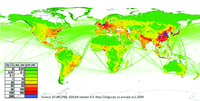
The figure shows the global greenhouse gas emission per capita
Climate change mitigation chapter SOER 2010

Climate change mitigation chapter SOER 2010

Climate change mitigation chapter SOER 2010

The graph shows development of dieselisation, defined as the percentage share of diesel cars in the total passenger car fleet, in 1995 and 2009.

The graph shows development of passenger cars ownership, defined as number of passenger cars per 1 000 inhabitants, in 1995, 2005, 2007 and 2009.

The graph shows the average age of passenger cars, light-duty vehicles, heavy duty vehicles, two-wheelers and buses, in 1995 and 2009.

The graph shows development of truck intensity, defined as number of trucks per million euro GDP, in 1995 and 2009.

The graph shows development of vehicle ownership, defined as number of passenger vehicles per 1 000 inhabitants, and truck intensity, defined as number of trucks per million euro GDP in constant 1995 prices , over the period 1995 to 2009.

The graph shows development of specific VOC emissions, defined as emissions of VOC per transport unit (passenger-km or tonne-km), by transport mode (road, rail, maritime, inland shipping, air) in 1995 and 2009.

The graph shows development of specific CO emissions, defined as emissions of CO per transport unit (passenger-km or tonne-km), by transport mode (road, rail, maritime, inland shipping, air) in 1995 and 2009.

The graph shows development of specific NOx emissions, defined as emissions of NOx per transport unit (passenger-km or tonne-km), by transport mode (road, rail, maritime, inland shipping, air) in 1995 and 2009.

The graph shows development of specific PM emissions, defined as emissions of PM per transport unit (passenger-km or tonne-km), by transport mode (road, rail, maritime, inland shipping, air) in 1995 and 2009.

The graph shows the change in emissions of primary PM10 data, and emissions of secondary PM10 precursors (SO2 and NOx and NH3) each weighted using aerosol formation factors (according to de Leeuw, 2002) NOx = 0.88, SO2 = 0.54 and NH3 = 0.64.

Overview of all non-fuel related charges and internalisation policies in EEA-32

The graph includes the combined emissions of primary PM10 particles (particulate matter with a diameter of 10 μm or less, emitted directly into the atmosphere) and secondary particulate-forming pollutants (the fraction of sulphur dioxide, SO2, nitrogen oxides NOx and ammonia NH3 which, as a result of photo-chemical reactions in the atmosphere, transform into particulate matter with a diameter of 10μm or less). Emissions of the secondary particulate precursor species are weighted by a particle formation factor prior to aggregation: primary PM10 = 1, SO2 = 0.54, NOx = 0.88, and (NH3) = 0.64.

The graph shows the emissions of primary PM10 particles (particulate matter with a diameter of 10 μm or less, emitted directly into the atmosphere) and secondary particulate-forming pollutants (the fraction of sulphur dioxide, SO2, nitrogen oxides NOx and ammonia NH3 which, as a result of photo-chemical reactions in the atmosphere, transform into particulate matter with a diameter of 10μm or less).
Emissions of the secondary particulate precursor species are weighted by a particle formation factor prior to aggregation: primary PM10 = 1, SO2 = 0.54, NOx = 0.88, and (NH3) = 0.64

The figure shows the emissions of acidifying pollutants (sulphur dioxide SO2, nitrogen oxides NOx and ammonia NH3) each weighted by an acid equivalency factor prior to aggregation to represent their respective acidification potentials. The acid equivalency factors are given by: w(SO2) = 2/64 acid eq/g = 31.25 acid eq/kg, w(NOx) = 1/46 acid eq/g = 21.74 acid eq/kg and w(NH3) = 1/17 acid eq/g = 58.82 acid eq/kg.

The graph shows the change in emissions of acidifying pollutants (sulphur dioxide SO2, nitrogen oxides NOx and ammonia NH3) each weighted by an acid equivalency factor prior to aggregation to represent their respective acidification potentials. The acid equivalency factors are given by: w(SO2) = 2/64 acid eq/g = 31.25 acid eq/kg, w(NOx) = 1/46 acid eq/g = 21.74 acid eq/kg and w(NH3) = 1/17 acid eq/g = 58.82 acid eq/kg.

The emissions of acidifying pollutants (sulphur dioxide SO2, nitrogen oxides NOx and ammonia NH3) are each weighted by an acid equivalency factor prior to aggregation to represent their respective acidification potentials. The acid equivalency factors are given by: w(SO2) = 2/64 acid eq/g = 31.25 acid eq/kg, w(NOx) = 1/46 acid eq/g = 21.74 acid eq/kg and w(NH3) = 1/17 acid eq/g = 58.82 acid eq/kg.

Real change in passenger and freight transport prices by mode, relative to average consumer prices (CP00). Data for entire EU-27 are available. However, very low consumer price indices in Romania and Bulgaria prior to their accession distort the weighted average and hence have been excluded.